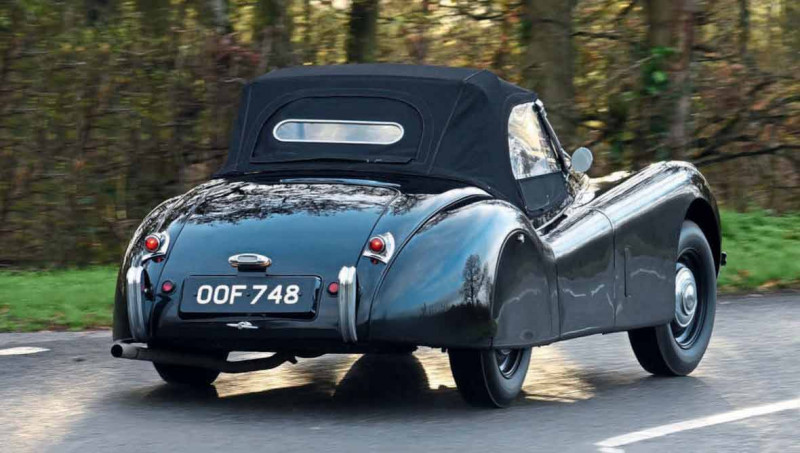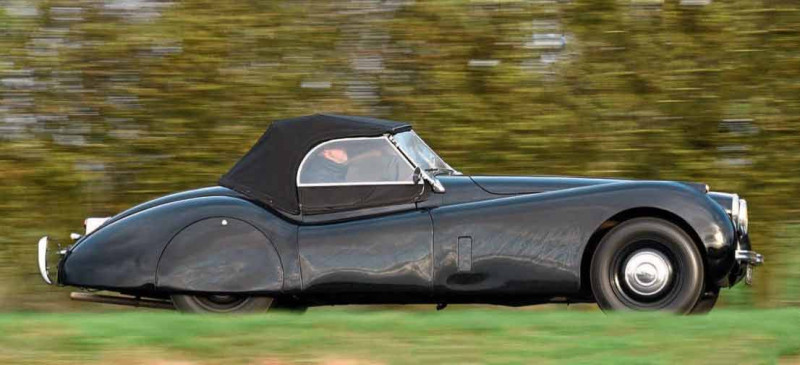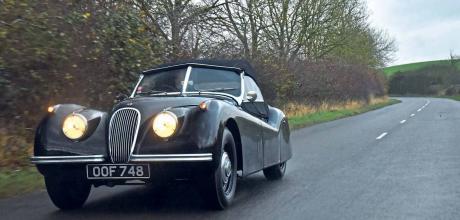1953 Jaguar XK120 OTS
We sample a late example of the 1953 Jaguar XK120 open-two-seater that, thanks to being owned by Jaguar since the Seventies, remains beautifully preserved, despite its recent adventures in motorsport.
Final countdown XK 120 OTS
Jaguar Heritage’s OOF 748 was 36th from the end of production, coming off the line in November 1953
If there are two nuggets of Wisdom I’ve picked up over many years writing about old cars, they are these: the dream and the reality don’t always coincide where classic cars and British weather are concerned, and no matter how many man hours or thousands of pounds have been spent on a lavish ‘nut-and-bolt’ restoration, there’s nothing quite like an original, unrestored car.

Both of these were borne out in a very practical way with our photoshoot of Jaguar Heritage’s famous XK 120, OOF 748. The day started badly, when instead of the shiny new company-issue Toyota hybrid, I chose to use a recently acquired Aston Martin for the journey to Jaguar Heritage’s Warwickshire base. Naturally, since the Aston in question was a DB7, I’d chosen it on the basis of its Jaguar connections, but if you take a look at our Classics World YouTube channel, you’ll see that this was quite possibly the cheapest Aston Martin of any kind in the country.
What could go wrong? Plenty, it would appear and just as I’d gone too far to nip back home and swap the Aston for something more reliable, the already erratic heater blowers went on strike, leaving me mopping the screen with paper towels and generally cursing at the foolishness of driving old cars in the British winter. Like I said, sometimes the dream and the reality don’t quite mesh, even with modern classics like the DB7.

Just a couple of hours later, though, the misery of the misted-up Aston was a distant memory as I splashed through the puddles in the XK 120 you see here, and the fact that the weather had worsened rather than improved by then tells you all you need to know about what a special experience the XK 120 is – and this XK 120 in particular.
A late example of the original XK, OOF 748 is essentially a two-owner car, having been sold new in 1953 via a dealer in Birmingham to its first owner in Leamington Spa. He clearly liked the car, because he kept it until 1970 when it was bought back by Jaguar, the car then becoming part of the Jaguar Daimler Heritage Trust’s collection in 1983, where it’s been ever since.
As a result, it’s an amazingly original example of the XK 120, of the kind all too rarely seen since the rising values of the cars started to make expensive rebuilds financially viable. Clearly, this makes it a valuable specimen, but the wonderful thing about Jaguar’s heritage collection is that they’re not afraid to use them and the cars are frequently seen on high-profile classic events. Often, they’re piloted by celebrities and you’ll see the cars being campaigned in anger on events such as the Mille Miglia and the Festival of Speed, which means they’re kept very much on the button by the team in the Gaydon workshops.
The XK 120 is no exception and scrutineering stickers on the screen bear witness to its entry into the Mille Miglia event in 2013 when it was driven by Daniel Day-Lewis together with the head of 20th Century Fox, Jim Gianopulos (see boxout), again in 2014, crewed by Jodie Kidd and David Blakeley and, in 2015, Kidd was joined by David Gandy. Having accompanied the Jaguar team myself on the 2011 event, I know from experience that ‘The Mille’ is a seriously competitive event where the astronomical values of the cars entered in the race is no deterrent to red mist as teams try to stick to the punishing schedule from Brescia to Rome and back.
It’s hard work spending long days at the wheel driving hard in cars of this vintage and it throws into perspective the achievements of the drivers who took so many victories for the XK 120 back in the Fifties.
A damp Monday morning in the Midlands is a long way from the southern Italian sun, but as we nosed the car out of the workshop and headed off into the Warwickshire countryside it didn’t matter – and as we climbed the twisty access roads to the nearby country park for our photos, it took only a small leap of the imagination to picture an XK 120 being campaigned on the ragged edge in an Alpine rally.
Like most cars of the era, the XK 120 isn’t an easy car to drive, or at least isn’t easy to drive well. Launched in 1948, it still feels like a Forties car in some respects – the cramped cabin being one of them, which requires a definite technique when clambering aboard to get your legs around the big-rimmed steering wheel, which sits close to your chest and virtually in your lap. The XK 120 also used the in famous Moss gearbox, which is notoriously awkward – and there’s a huge amount of urban rumour grown up around the subject. In reality, though, it’s no worse than many other cars of the period and once you’re used to it then crunch-free changes become second nature.
It helps that I’m constantly driving old machinery and just a few days previously had been driving a Healey 3000 and a Frogeye Sprite, but anyone used to driving a Morris Minor with its non-synchro first will master the Moss ’box in a couple of miles. You can’t rush the upshifts and double-declutching is the order of the day coming back down, but once the shift is mastered, there’s a real satisfaction to be had from driving the car smoothly. By the standards of its day it’s remarkably sharp despite running on crossply tyres.
It’s also remarkably lively and the perfect illustration of just why the XK engine remained in production for so long. Our camera car for the tracking photography was a modern Mini Cooper S, but with 160bhp from its 3.4 litres, the 70-year-old Jaguar didn’t struggle to keep up. And although I didn’t stretch it as hard as the Mille contestants would have done, I’ve no doubt it would still be good for its official 125mph top speed, and certainly the 120mph after which it was named.
It’s also impressively flexible – no doubt the result of the attention lavished on preparing it by the Jaguar Heritage team – and happy to pull without hesitation from walking pace, which isn’t something you can often say about carburetted cars of this age.
Cornering naturally requires more caution, especially in the wet, as the chassis – essentially a shortened version of that found under the Mk V – was notably less advanced than the engine, using a leaf-sprung live rear axle and drum brakes. Although perfectly adequate, they don’t have the bite of the discs fitted to more modern classics. Indeed, start to push it in the bends and you realise just why the wheel is so big and why you’re sitting so close to it: quite simply you need the leverage to place the car accurately.
The age of the design also shows in the weather equipment. The XK 120 was offered in three forms: the regular fixedhead coupe, a drophead coupe and open-two-seater. OOF is the latter. Whereas the DHC was relatively luxurious and offered a padded, lined hood and winding windows, the OTS was a spartan affair, designed to appeal to the more serious sporting Fifties motorist. The hood was a simple single-skinned fabric make-up, while the side windows were slot-in side screens held on simple brackets with a fabric flap to access the inner door latches.
Yes, it’s as draughty as it sounds, but, in truth, it works better than you might think and the OTS did at least come with a useful heater, so on the move the cabin stays just the right side of needing gloves.
Coming very late in the production run – in fact, just 36 cars from the end of production – OOF represents the XK 120 in its ultimate form, with all the wrinkles ironed out, and it was a privilege to drive such an original example, too. Much has been made this year of the E-type, but, more than any other, the XK 120 was the car that made Jaguar as a brand and there can be no better reminder of where the legend came from.
Indeed, after spending the day in the XK 120, my V12 Aston Martin seemed rather, well, humdrum. Oh, and the screenwash pump failed half-way home. Now, what was that about old cars and winter weather?
Thanks to: Jaguar Daimler Heritage Trust (www.jaguarheritage.com)
DOUBLE TAKE
Paul Walton remembers a unique moment with OOF 748 from the 2013 Mille Miglia In 2013, I was invited to join Jaguar Heritage to be part of its support crew on that year’s Mille Miglia. The big news was that together with the head of 20th Century Fox, Jim Gianopulos, Daniel Day-Lewis would be driving OOF 748.
As one of the world’s most famous actors, and fresh from winning his third Academy Award, the star of Lincoln and Gangs of New York was constantly being swamped by the press and spectators. So, as the competition cars queued on Brescia’s Viale Venezia waiting to climb the ceremonial ramp for their individual start, Day-Lewis was in an XF Sportbrake at the end of the road, only joining Gianopulos at the last minute.
With the passenger seat of OOF empty, I was asked by Tony O’Keeffe, then curator of Jaguar Heritage, if I’d like to join the American movie mogul, an offer I gladly accepted. So, for the next half hour we chatted about the car. Gianopulos, it turns out, is a huge classic Jaguar enthusiast, owning a similar XK 120 at home.
With OOF 748 known to be Day-Lewis’ car, we were constantly surrounded by excited spectators, all hoping to catch a glimpse of this legendary film star. The bitter disappointment on their faces when they saw me was all too clear, while others must have looked at their pictures and thought, “That Day-Lewis has let himself go.”
With the start now in sight, I wished Gianopulos good luck and held the door open for the actor to dive in, saying, “I’ve kept the seat warm for you.”
Paul’s view down OOF 748’s long, black bonnet during his time as Daniel Day-Lewis’ stunt double
Daniel Day-Lewis and Jim Gianopulos in OOF 748 at the start of the 2013 Mille Miglia


